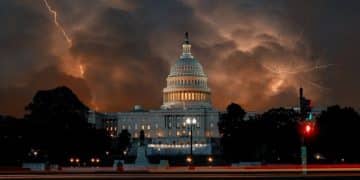Trump’s Financial Regulation Changes: Impact on US Banks & Investors

The Trump administration implemented significant changes to financial regulations, aiming to boost economic growth, but these changes had varied impacts on US banks and investors, including altered risk profiles and compliance burdens.
The **Trump Administration’s Changes to Financial Regulations: How Will They Affect US Banks and Investors?** This question has been central to economic debates in the United States. Understanding these changes provides critical insight into the shifts in the financial landscape and their consequences.
Understanding the Dodd-Frank Act and Its Initial Impact
The Dodd-Frank Wall Street Reform and Consumer Protection Act, enacted in 2010 in response to the 2008 financial crisis, aimed at reforming the financial system. It was a sweeping piece of legislation, affecting nearly every aspect of the financial industry. Now it’s important to understand how this affected the economy.
Key Provisions of the Dodd-Frank Act
The Dodd-Frank Act included several key provisions designed to increase stability and transparency within the financial system.
- Creation of the Consumer Financial Protection Bureau (CFPB): To protect consumers from predatory financial practices.
- The Volcker Rule: This restricted banks from making speculative investments with depositors’ money.
- Systemically Important Financial Institutions (SIFIs): Enhanced oversight of firms deemed “too big to fail.”
- Derivatives Regulation: Increased transparency and regulation of the derivatives market.

These provisions aimed to prevent another financial crisis by tightening regulations on banks and other financial institutions. However, critics argued that the Dodd-Frank Act stifled economic growth and placed undue burdens on community banks.
Deregulation Under the Trump Administration: An Overview
Upon entering office, the Trump administration prioritized rolling back many of the regulations put in place by the Dodd-Frank Act. The administration argued that these regulations were hindering economic growth and making it harder for banks to lend money. Let’s see what key deregulatory measures were taken.
Key Deregulatory Measures Enacted
Several key deregulatory measures were enacted under the Trump administration, primarily aimed at easing the regulatory burden on banks and encouraging economic growth.
- Economic Growth, Regulatory Relief, and Consumer Protection Act (EGRRCPA): This law, passed in 2018, rolled back some of the Dodd-Frank Act’s regulations for smaller banks.
- Changes to the Volcker Rule: The administration eased restrictions on banks’ ability to make certain investments..
- CFPB Reforms: Efforts were made to curb the power and scope of the Consumer Financial Protection Bureau.
These measures were intended to stimulate economic growth by freeing up capital and reducing compliance costs for financial institutions, especially smaller banks.
Impact on US Banks: Lending and Profitability
One of the main goals of the Trump administration’s deregulation efforts was to boost lending and profitability for US banks. The argument was that reducing regulatory burdens would allow banks to extend more credit and increase their returns. But How did it really affect banks?

Following the implementation of these deregulatory measures, many banks reported increased lending activity. Smaller banks, in particular, benefited from the changes, as they were no longer subject to the same level of scrutiny as larger institutions. This led to:
- Improved lending environment for small businesses and individuals.
- Increase profitability for small and medium-sized banks.
- Overall stability of the banking sector, due to freed up capital.
Some detractors of the deregulation policies, however, worried about the risks of loosening regulations and the potential for banks to take on excessive risks, potentially repeating mistakes that led to the 2008 financial crisis.
Effects on Investors: Risk and Return
Changes to financial regulations have a direct impact on investors, influencing the risk-return profile of various investment opportunities. It’s important to consider both benefits and potential drawbacks.
Changes in Investment Landscape after Deregulation
The deregulation measures introduced by the Trump administration altered the investment landscape in several ways:
- Increased Investment Opportunities: With banks more willing to lend, new investment opportunities emerged.
- Higher Returns: Some investors experienced higher returns due to increased risk-taking by financial institutions.
- Potential Risks: The loosening of regulations raised concerns about increased market volatility and potential for financial instability.
The impact of these financial landscape changes, depends heavily on individual choices and preferences. But to take advantage of the changes one must fully understand them.
Criticisms and Concerns Regarding Deregulation
While deregulation aimed to stimulate economic growth, it also faced significant criticism and raised concerns among economists and regulators. Now lets review the core of the worries and criticisms directed towards deregulating the economy.
Arguments Against the Deregulatory Agenda
Critics argued that the rollback of Dodd-Frank regulations could lead to increased risk-taking by banks, and potentially destabilize the financial system. They emphasized issues such as:
- Weakening consumer protection mechanisms.
- Increase risk for banks and financial instutitions.
- Potential return to pre-2008 crisis conditions.
These critiques underscore the ongoing debate about the appropriate level of regulation needed to balance economic growth and financial stability.
The Future of Financial Regulations in the US
The future of financial regulations in the US remains uncertain, with shifting political priorities and evolving economic conditions. It is likely we will see further changes moving forward.
Potential Scenarios for the Future and What to Expect
Several potential scenarios could shape the future of financial regulations in the United States:
- Further Deregulation: A continuation of the trend toward deregulation, potentially leading to looser lending standards and increased risk-taking.
- Re-Regulation: A shift back toward stricter regulations, driven by concerns about financial stability and consumer protection.
- Continued evolution: Financial regulations continue to evolve to match global events and economic circumstances.
| Key Point | Brief Description |
|---|---|
| 🔑 Dodd-Frank Act | Comprehensive reform to prevent another financial crisis. |
| ⚖️ Deregulation | Trump administration eased regulations for economic growth. |
| 🏦 Impact on Banks | Increased lending and profitability, especially for smaller banks. |
| 💰 Investor Effects | New oppurtunities, but investors should always be vigilant. |
Frequently Asked Questions
▼
The Dodd-Frank Act aimed to reform the financial system after the 2008 crisis, focusing on increasing transparency and preventing future economic meltdowns by regulating financial institutions.
▼
The Trump administration eased several Dodd-Frank regulations in an effort to reduce the compliance burden on financial institutions and promote economic growth for smaller businesses.
▼
Critics worried about the stability of the financial system; and potential risks from weaker consumer protection efforts, and they generally worried about the overall welfare of the system.
▼
Smaller banks generally benefitted from the regulatory changes as the compliance burden was reduced which promoted increased lending and improved their overall profitability and stability.
▼
The future of financial regulations hinges on political priorities and the evolving economic environment. We could see additional deregulation or a shift to stricter regulations based on current economic circumstances.
Conclusion
The Trump administration’s changes to financial regulations have had a significant impact on US banks and investors. While deregulation sought to stimulate economic growth, it also raised concerns about increased risk and financial instability, which continues to fuel ongoing discussions about the appropriate balance between regulation and economic development.





